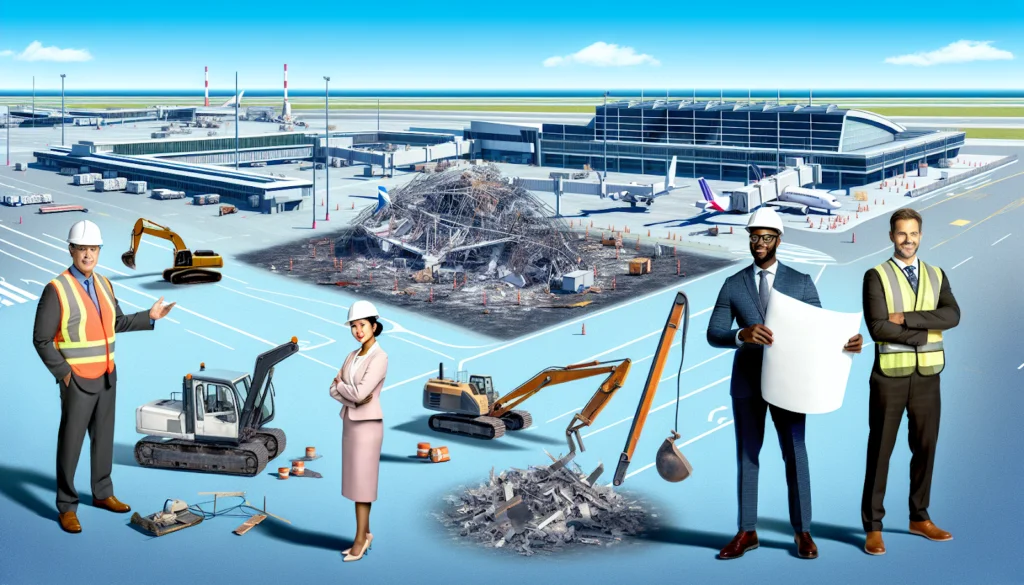Successfully managing logistics and obtaining the necessary security clearances for airport demolition is a complex task that involves strict adherence to regulations and safety protocols. This guide will provide an uncomplicated walkthrough of the crucial steps involved in complying with FAA and TSA guidelines, ensuring a legally sound and secure demolition process.
Key Takeaways
- Airport demolition requires careful compliance with federal regulations, coordination with agencies like the FAA and TSA, and consideration of hazards to navigable airspace, including permanent structures and temporary constructions.
- Security clearances play a vital role in airport demolition, necessitating a comprehensive vetting process, adherence to classified information handling protocols, and implementing robust access control measures to ensure site security.
- Effective airport demolition is a balancing act that involves ensuring minimal disruption to airport operations, maintaining safety and compliance onsite, and achieving cost-efficiency and timeliness through selecting demolition methods and optimizing processes.
Navigating the Demolition Process at Airports

establishes standards for objects affecting navigable airspace, a critical aspect of airport demolition projects.
Proponents must submit the FAA form 7460-1, ‘Notice of Proposed Construction or Alteration’, along with supplemental information such as site drawings, distances from runways, and precise geodetic coordinates to facilitate this coordination. This notification helps the FAA evaluate the impacts before work begins, ensuring safety and compliance, and maintaining harmony between the demolition process and airport operations.
Ensuring Safety and Compliance On-Site
The FAA prioritizes safety in the sky, but ensuring security on the ground is also crucial. At demolition sites, where heavy machinery and workers are frequently involved, smart thermal cameras are utilized as part of the security system. These advanced cameras can detect intruders and promptly send alerts specifying their position, speed, direction, and location on site.
It’s always better to prevent issues before they arise. That’s why access control measures are specifically designed to restrict unauthorized entry at demolition sites. By implementing both monitoring techniques and preventive measures together, we can guarantee that these sites remain safe for all individuals involved, including workers and passengers.
Obtaining Necessary Security Clearances

Security clearances are crucial for demolishing airports as they act like keys that grant access to airport demolition projects. These clearances are obtained through a thorough vetting process that can take several months and involves checks for any potential risks or trustworthiness issues. This process isn’t limited to top officials only. Even Transportation Security Officers who conduct TSA security checks must undergo an SF-85P check for positions involving public trust.
For higher management roles, obtaining at least a Secret clearance requires completing an SF-86 form. This level of clearance is necessary to maintain adequate security levels within airports and ensure safe operations during demolition projects. Overall, acquiring these necessary credentials is critical in upholding safety measures within airport settings.
Types of Security Clearances
Although commonly referred to as a single term, ‘security clearance’ encompasses multiple clearances with specific purposes. These classifications are relevant for airport security and include non-sensitive, public trust, and national security positions.
When it comes to national security roles at airports, there are four primary levels of clearance:
- Confidential
- Secret
- Top secret
- Sensitive compartmented information (SCI)
Each level grants access to different tiers of classified information and requires periodic reinvestigation. Interim security clearances may be granted temporarily until a thorough background check is completed.
This intricate system ensures that only authorized individuals can access sensitive data within airport security to keep such confidential information secure.
The Clearance Application Process
Obtaining a security clearance involves several steps, including interviews, background checks, drug screenings, and completion of disclosure forms. This is in accordance with the FAA’s guidelines under 14 CFR Part 77, where individuals must provide detailed information about any proposed construction or alteration at an airport.
Following this aeronautical study by the FAA, which assesses potential hazards to navigable airspace, appropriate mitigating measures are determined to ensure safe air navigation, demonstrating that securing clearance is not just based on individual trustworthiness but also takes into account the impact of projects on airports and ultimately ensuring passenger safety.
Handling Classified Information
After obtaining clearance, the responsibility of managing classified information becomes a top priority. Airport Security Programs (ASPs) and unique security requirements for airports are considered sensitive material known as sensitive security information (SSI). To uphold security integrity, these protocols cannot be accessed by the public. Certain positions at an airport may also require financial disclosure forms to prevent potential vulnerabilities related to money laundering.
The handling of classified information is essential in maintaining proper procedures and securing all aspects of airport logistics during demolition processes. When transporting any U.S. confidential materials through an airport, strict instructions must be adhered to so that the screening process remains secure and there is no compromise on sensitive data being transported. These measures guarantee that the clearance process is secure and ensure maximum protection when dealing with classified information within airports while meeting all necessary requirements set forth.
Implementing Effective Access Control Measures

Access control serves as the gatekeeper of airport security, effectively managing entry to designated areas and preventing unauthorized access to sensitive zones. It is a crucial component in maintaining the fortress-like protection of airports during demolition.
At demolition sites, access control systems play a critical role in regulating and monitoring entrance into physical locations. These systems are reinforced by tangible barriers such as perimeter hoarding and security fencing used at the early stages of site development to discourage trespassing or vandalism. Similar to walls surrounding a fortress, these measures act as protective shields for the airport against unwanted intrusions.
Physical Barriers and Surveillance Systems
The primary line of defense in airport security comprises physical barriers and surveillance systems. These technologies include smart thermal cameras that function effectively under different lighting conditions and perimeter security consisting of fences and hoardings around the construction site. Monitored alarm systems are utilized to provide an extra layer of protection.
These measures work hand-in-hand to uphold safety and security within airports. Together, they form a powerful shield to protect the sterile area on demolition sites from any potential threats or intrusions.
Credential Management
Effective credential management is essential for maintaining security and allowing authorized personnel to access specific areas. To obtain a temporary airport pass, employees and contractors must undergo an interview, provide biometric information, and have their photo taken at the Pass Office. As part of these procedures, a body scanner may also be used.
To guarantee that only permitted individuals are granted entry into restricted zones at the airport, identification verification systems utilizing access cards, personal identification numbers (PINs), and biometrics work with passes provided by the Pass Office. By implementing this efficient form of credential management, the appropriate individuals can easily gain access when necessary without compromising overall security measures.
Responding to Unauthorized Access
Despite the implementation of top-notch security protocols, it is still possible for unauthorized access incidents to occur. In such situations, a prompt and efficient response becomes crucial. This is where access control systems play a significant role by swiftly identifying individuals and addressing any instances of unauthorized entry.
Visitor management systems offer various advantages in terms of airport security, including accurate identification of visitors, assigning appropriate levels of access to them, rapid handling of unauthorized access attempts, swift containment and resolution procedures for breaches in security as well as ensuring maintenance and preservation of airport integrity during demolition phases.
Coordination With Airport Operations

Airports can be compared to living organisms, as they are constantly bustling with a variety of operations occurring simultaneously. This is the case for numerous airports, where demolition becomes part of the equation and coordination with airport activities is crucial. This involves communication with air traffic control, managing passenger and employee movements effectively, and creating schedules that minimize disruptions.
Efficiently replacing outdated facilities at an airport requires well-coordinated construction phases involving multiple disciplines to keep interruptions minimal while still maintaining essential services. It is important to have flexibility in demolition plans and construction plans so any unexpected changes can be accommodated without causing disturbances in airport operations. The key factor here is to synchronize the timing of demolition work with the ongoing flow of airport activities to ensure seamless functioning.
Communicating With Air Traffic Control
The airport demolition process requires efficient communication with air traffic control, which plays a vital role as the conductor of the airport. With advancements in air traffic control automation systems, precise information is readily available to ensure situational awareness and prevent disruptions to flight operations during demolition.
Through remote digital towers, controllers have enhanced monitoring capabilities over all activities on the airfield affected by the demolition. This guarantees that every step of the demolition process flows smoothly without interrupting other ongoing operations at the airport.
Managing Passenger and Employee Movements
It is important to manage the movements of passengers and employees during airport demolition in order to minimize disruption. Collecting data on traffic patterns is crucial for determining when temporary lane closures can occur without significantly impacting passenger flow.
To maintain continuous traffic flow, it may be possible to repurpose underutilized roadways and create additional lanes while making minimal changes to existing structures. Clear communication about any changes in airport layout and alternative transportation options should also be provided in advance, ensuring a smoother experience for travelers during construction periods. The ultimate goal is to keep the process of demolition backstage so that it remains invisible to both passengers and employees at all times.
Scheduling for Minimal Disruption
Demolition activities should be scheduled strategically during low traffic periods or off-peak hours to minimize disruption and maintain smooth airport operations. Analyzing data on flight activity and roadway demands is crucial in determining the most suitable times for demolition that will have minimal impact on travelers. Microsimulation traffic modeling is a valuable tool that can help evaluate different phasing plans for demolitions and their effect on airport operations. This ensures an efficient process without causing any interruptions in the flow of operations at the airport.
Cost-Efficiency and Timeliness in Airport Demolition Projects

Effective airport demolition involves finding a balance between maintaining security, ensuring efficiency, and managing costs. Choosing the right methods for demolishing structures is about meeting regulatory standards and maximizing operational effectiveness.
Employing GPS-equipped machinery during airport demolition increases accuracy and reduces project timeframes. Careful scheduling guarantees that resources are allocated in the most efficient way possible to keep costs down. This approach prioritizes timely demolition execution while minimizing expenses.
Budgeting for Security Measures
Security is an uncompromising element of airport demolition. However, implementing rigorous security protocols, which involve advanced screening and monitoring of demolition crews, can be high. Therefore, regular risk assessments are vital for maintaining cost-effective airport security.
Evaluating the cost-effectiveness of security measures on a regular basis helps ensure that airport security funds are utilized efficiently and do not contribute to unnecessary spending. Cost savings in airport security can also stem from:
- Optimization of HVAC systems to eliminate energy waste
- Implementation of data-driven equipment maintenance to prolong the life cycle
- Informed capital expenditure decisions
This ensures that security regulations, while paramount, don’t become a financial burden.
Streamlining Demolition Processes
Efficient demolition processes are crucial for minimizing time and cost. Implementing real-time data monitoring speeds up the process of identifying and addressing inefficiencies, resulting in smoother demolitions at airports.
Incorporating data-driven strategies into maintenance and operations can greatly improve on-site efficiency, ultimately reducing the demands placed on security protocols during demolition. This highlights the importance of bringing down structures and doing so in a streamlined manner to optimize resources and costs.
Case Study: Successful Airport Demolition
The demolition project at San Francisco International Airport serves as an example of effective management when it comes to logistics and security clearances. By implementing its Construction & Demolition Debris Management program, it was able to divert 75% of waste, demonstrating a commitment towards sustainable waste practices that align with both cost-effective measures and environmental goals.
This case study demonstrates the potential for improved efficiency in airport demolitions through the use of metrics such as tracking diversion targets and conducting annual surveys on waste disposal. It proves how important mastering logistics and ensuring strict adherence to security protocols can result in successful outcomes for airport construction projects.
Summary
The demolition of an airport is a complex and intricate process that requires careful handling of logistics, security clearances, compliance with federal regulations, and coordination with TSA and FAA authorities. It also involves obtaining necessary clearance approvals and implementing access control measures to maintain safety while minimizing costs. Striking a balance between ensuring top-notch security standards, efficiency in operations, and cost-effectiveness is crucial for the success of any airport demolition project, as exemplified by San Francisco International Airport’s case. If you have an upcoming demolition project, contact Bella Contacting Services for expert heavy demolition nationwide.
Frequently Asked Questions
What kind of security clearance do you need to work at the airport?
For management positions and above at the airport, you need a Secret clearance or higher, obtained by completing the SF-86 form.
Entry-level Transportation Security Officers do not require a security clearance but fill out an SF-85P for a position of public trust.
What is airport security clearance called?
TSA PreCheck, Global Entry, and CLEAR are different programs offered for airport security clearance that enable travelers to go through faster screening lines. These initiatives aim to simplify the airport security process for those who meet eligibility criteria.
What is 49 CFR Part 1542?
49 CFR Part 1542 provides rules for airport operators and describes aviation security rules governing the operation of airports regularly serving aircraft operations.
What is the role of the FAA in airport demolition?
The FAA establishes the standards and notification requirements for objects that impact navigable airspace, such as airport demolition projects. These projects must adhere to notice obligations according to 14 CFR Part 77 guidelines.
What is involved in obtaining security clearances for airport demolition projects?
Obtaining security clearances for airport demolition projects entails a comprehensive screening procedure that includes personal interviews, background investigations, drug tests, and disclosure form submissions. This vetting process typically takes several months to finalize before clearance can be granted.



